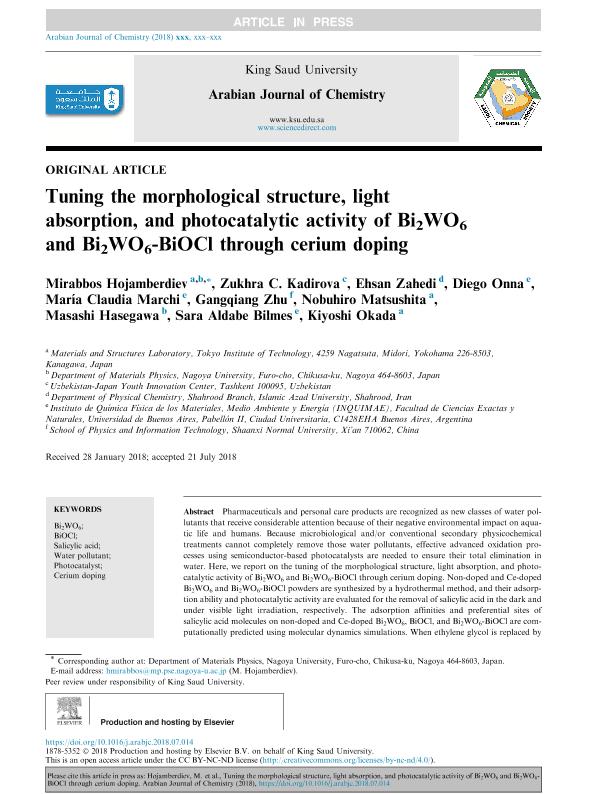Artículo
Tuning the morphological structure, light absorption, and photocatalytic activity of Bi2WO6 and Bi2WO6-BiOCl through cerium doping
Hojamberdiev, Mirabbos; Kadirova, Zukhra C.; Zahedi, Ehsan; Onna, Diego Ariel ; Marchi, María Claudia
; Marchi, María Claudia ; Zhu, Gangqiang; Matsushita, Nobuhiro; Hasegawa, Masashi; Aldabe, Sara Alfonsina
; Zhu, Gangqiang; Matsushita, Nobuhiro; Hasegawa, Masashi; Aldabe, Sara Alfonsina ; Okada, Elena
; Okada, Elena
 ; Marchi, María Claudia
; Marchi, María Claudia ; Zhu, Gangqiang; Matsushita, Nobuhiro; Hasegawa, Masashi; Aldabe, Sara Alfonsina
; Zhu, Gangqiang; Matsushita, Nobuhiro; Hasegawa, Masashi; Aldabe, Sara Alfonsina ; Okada, Elena
; Okada, Elena
Fecha de publicación:
07/2018
Editorial:
Elsevier
Revista:
Arabian Journal of Chemistry
ISSN:
1878-5352
Idioma:
Inglés
Tipo de recurso:
Artículo publicado
Clasificación temática:
Resumen
Pharmaceuticals and personal care products are recognized as new classes of water pollutants that receive considerable attention because of their negative environmental impact on aquatic life and humans. Because microbiological and/or conventional secondary physicochemical treatments cannot completely remove those water pollutants, effective advanced oxidation processes using semiconductor-based photocatalysts are needed to ensure their total elimination in water. Here, we report on the tuning of the morphological structure, light absorption, and photocatalytic activity of Bi2WO6 and Bi2WO6-BiOCl through cerium doping. Non-doped and Ce-doped Bi2WO6 and Bi2WO6-BiOCl powders are synthesized by a hydrothermal method, and their adsorption ability and photocatalytic activity are evaluated for the removal of salicylic acid in the dark and under visible light irradiation, respectively. The adsorption affinities and preferential sites of salicylic acid molecules on non-doped and Ce-doped Bi2WO6, BiOCl, and Bi2WO6-BiOCl are computationally predicted using molecular dynamics simulations. When ethylene glycol is replaced by dilute HCl as a solvent in a hydrothermal system, BiOCl is also formed along with Bi2WO6, confirming the successful formation of a Bi2WO6-BiOCl composite. The flower-like hierarchical structures of Bi2WO6 and Bi2WO6-BiOCl can absorb more photon energy due to multiple scattering, charge carriers can easily transfer to the surface/interface, and mesopores can improve the transfer rate of organic molecules, contributing to the overall enhancement in photocatalytic activity. The Bi2WO6-BiOCl samples show higher photocatalytic activity than that of the Bi2WO6 samples for the degradation of salicylic acid due to the formed p–n heterojunction. The optimum concentration of Ce doping is found to be 1 mol% in the Bi2WO6 and Bi2WO6-BiOCl, promoting the effective separation and transfer of photogenerated charge carriers, resulting in high photocatalytic performance, and the sample exhibited good stability.
Palabras clave:
BI2WO6
,
BIOCL
,
CERIUM DOPING
,
PHOTOCATALYST
,
SALICYLIC ACID
,
WATER POLLUTANT
Archivos asociados
Licencia
Identificadores
Colecciones
Articulos(IFIBA)
Articulos de INST.DE FISICA DE BUENOS AIRES
Articulos de INST.DE FISICA DE BUENOS AIRES
Articulos(INQUIMAE)
Articulos de INST.D/QUIM FIS D/L MATERIALES MEDIOAMB Y ENERGIA
Articulos de INST.D/QUIM FIS D/L MATERIALES MEDIOAMB Y ENERGIA
Articulos(SEDE CENTRAL)
Articulos de SEDE CENTRAL
Articulos de SEDE CENTRAL
Citación
Hojamberdiev, Mirabbos; Kadirova, Zukhra C.; Zahedi, Ehsan; Onna, Diego Ariel; Marchi, María Claudia; et al.; Tuning the morphological structure, light absorption, and photocatalytic activity of Bi2WO6 and Bi2WO6-BiOCl through cerium doping; Elsevier; Arabian Journal of Chemistry; 11; 7-2018; 1-14
Compartir
Altmétricas



